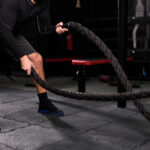Kettlebell lunges are a dynamic and effective way to enhance your lower body strength, stability, and coordination. Ideal for athletes, fitness enthusiasts, and anyone looking to spice up their workout regimen, these exercises not only target your legs but also engage your core and improve your balance. Kettlebell lunges stand out due to their versatility and the added challenge of incorporating a kettlebell, which intensifies the workout and promotes muscle engagement. Whether you’re a beginner or a seasoned pro, integrating kettlebell lunges into your routine can lead to remarkable fitness gains and a more sculpted physique.
Basic kettlebell lunge technique
Mastering the basic kettlebell lunge technique is crucial for maximizing the benefits of the exercise while minimizing the risk of injury. Here’s how to perform a standard kettlebell lunge:
- Starting position: Stand upright with your feet shoulder-width apart. Hold a kettlebell in your right hand, arm hanging naturally at your side.
- The lunge: Step forward with your left leg, bending your knee to about 90 degrees. Ensure your left knee is aligned with your ankle, not pushing past your toes.
- Lower your body: As you step forward, lower your body by bending your right knee towards the floor. Aim to keep your back straight and maintain an upright torso to avoid leaning forward.
- The lift: Press firmly through your left heel to lift yourself back to the starting position. Repeat the movement on the opposite side.
Focus on smooth, controlled movements. The kettlebell should remain securely in your hand, with your arm stable and movements fluid.
Variations of kettlebell lunges
Expanding your workout to include various kettlebell lunge variations can help challenge different muscle groups and keep your routines fresh and engaging. Here are some popular variations:
- Kettlebell reverse lunge: This involves stepping backward instead of forward. It puts less stress on the knees and targets the glutes and hamstrings more intensely.
- Kettlebell walking lunge: Carry the kettlebell as you step forward into a lunge and continue moving forward, alternating legs. This variation increases cardiovascular intensity and dynamic balance.
- Kettlebell lateral lunge: Step out to the side instead of forward, keeping the kettlebell in the opposite hand of the stepping leg. This targets the inner and outer thighs.
- Kettlebell curtsy lunge: Step your leg behind you and to the opposite side, as if performing a curtsy. This variation focuses more on the inner thighs and glute medius.
- Double kettlebell lunge: Increase the challenge by holding a kettlebell in each hand. This not only adds weight but also requires more core engagement to stabilize your body during the movement.
If you need more ideas for variations and how to work your lower body with kettlebells, make sure to get in touch with our personal trainer in Sanford.
Expand your range of leg and core strength exercises, master the kettlebell front squat.
Safety tips and injury prevention
When incorporating kettlebell lunges into your workout, safety should always come first. To prevent injuries and maximize the effectiveness of your exercise, keep these tips in mind:
- Warm-up properly: Begin with a thorough warm-up to prepare your muscles and joints for the workout. Dynamic stretches that mimic the lunge motion can be particularly effective.
- Use appropriate weight: Start with a weight that allows you to maintain proper form. As you become more comfortable with the movements, you can gradually increase the kettlebell’s weight.
- Maintain correct posture: Keep your back straight and your core engaged throughout the exercise. This helps distribute the weight evenly and reduces the strain on your lower back.
- Focus on form over speed: Execute each movement with control. Rushing through the exercises increases the risk of slipping or twisting something improperly.
- Listen to your body: Pay attention to any signs of discomfort or pain. If something feels wrong, stop immediately and adjust your form or reduce the weight.
- Wear proper footwear: Use stable, non-slip shoes to ensure a firm footing and to provide adequate support for your ankles during the movements.
Final thoughts
Kettlebell lunges are a fantastic addition to any fitness regimen, offering benefits that extend beyond simple leg strength to include core stability, balance, and functional mobility. Whether you stick with the basic technique or explore its variations, you can tailor this exercise to meet your specific fitness goals.
Remember to focus on proper form and gradually integrate more challenging variations and heavier weights as you progress. With consistency and attention to safety, kettlebell lunges can be a game-changer in your quest for a stronger, more balanced body.





